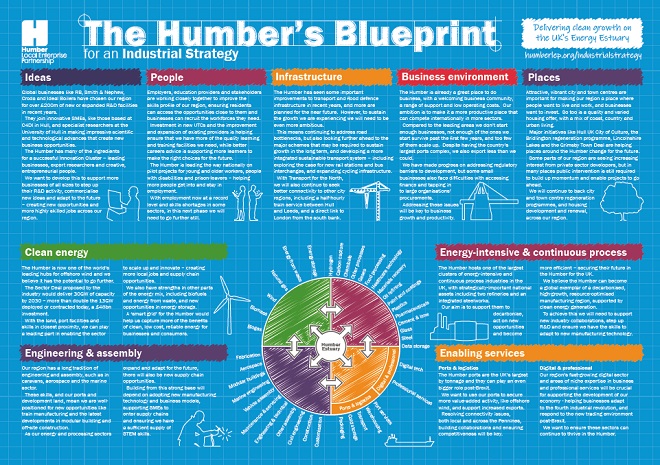Posted on 12th June 2018
Category: News
The Humber Local Enterprise Partnership (LEP) launched its Blueprint for a Humber Industrial Strategy at its Future Summit a major Business Week event attended by leaders from business, councils and education.
The document kicks off the region’s bid to build on the progress it has made as the Energy Estuary over recent years, as it seeks to attract new investment in low carbon industries and support existing industries to reduce their emissions and become more efficient.
“Clean growth” is one of the four Grand Challenges set out in the Government’s UK Industrial Strategy at the end of last year, and the LEP believes that the Humber can play a leading part in delivering it.
The document also highlights new opportunities for the region in engineering, digital tech and for the Humber ports post-Brexit.
The priorities identified in the Blueprint include:
Calling on Government to back the Sector Deal being proposed by the offshore wind sector, which would see capacity more than double from 13GW to 30GW by 2030 – a £48bn investment. With the Humber’s close proximity to planned wind farms and assets in ports, land and skills, the LEP believes the region could stand to benefit further. The chair of the Offshore Wind Industry Council, Benj Sykes, spoke about the proposed deal this morning.
Attracting new assembly activity, like wind turbines in Hull and trains in Goole, building on the region’s engineering skills and ability to import and manufacture components.
Ensuring the Humber ports play a bigger role post-Brexit, handling more UK trade and hosting more “value-added” manufacturing and customisation activity. The Humber is already taking over some of the strain from congested southern ports, and could handle a larger share of traffic coming from northern England and Scotland. Access has recently been improved to the Port of Immingham, and it is essential that the A63 Castle Street scheme proceeds to improve access to the Port of Hull.
Developing the region’s growing tech industry, helping more of the Humber’s manufacturers to take advantage of new technology in areas like automation and robotics. The LEP announced today that its Growth Hub will be launching a support programme to aid this later this year.
Further expanding the region’s growing research and development base, creating more high quality skilled jobs. Recent global investments by companies such as Indivior, RB, Smith & Nephew, Croda and Ideal Boilers totalling over £200m have shown that the region can deliver on R&D – but it has lacked the profile for this in the past. The LEP believes that developing the region’s Innovation Cluster would put the region at the forefront of developing and manufacturing more new products and services, in sectors such as pharmaceuticals and energy.
The Blueprint also maps out a continued focus on skills, infrastructure improvements and regeneration.
The document has been developed following initial discussions with businesses over the last few months. The LEP now wants to start a public debate on the region’s future economic focus, and is calling for businesspeople and residents to come forward with their ideas for how the region can become more productive and prosperous. The consultation will run over the summer, with more detailed proposals to be developed in the autumn.
The Blueprint also reveals that the LEP will be seeking Government backing for the proposals, ensuring the Humber – as one of the UK’s main industrial clusters – is one of the next regions to agree a Local Industrial Strategy after the three areas currently in discussions (Greater Manchester, West Midlands and Oxfordshire). The proposals will be developed over the coming weeks and months, and the LEP wants to join with MPs, council leaders and business organisations to seek support for the region’s plans.
Speakers at the Future Summit included Lord Haskins, Alan Johnson, Benj Sykes (Vice President, Ørsted), Paul Martin (Deputy CEO, British Steel), Lee Hopley (Chief Economist, EEF) and Professor Susan Lea (Vice Chancellor, University of Hull).
Click here to download the Blueprint document (PDF File)
Printed copies are available from the LEP office.
Share this article
